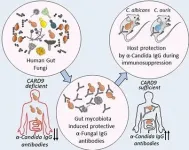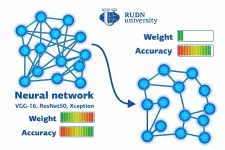Center for BrainHealth researchers create virtual reality cognitive assessment
Virtual reality assessment effectively tests executive function in a real-world setting
2021-02-05
(Press-News.org) Virtual reality isn't just for gaming. Researchers can use virtual reality, or VR, to assess participants' attention, memory and problem-solving abilities in real world settings. By using VR technology to examine how folks complete daily tasks, like making a grocery list, researchers can better help clinical populations that struggle with executive functioning to manage their everyday lives.
Lead author Zhengsi Chang is a PhD student that works in the lab of Daniel Krawczyk, PhD, deputy director of the Center for BrainHealth®. Along with Brandon Pires, a researcher at Texas Tech University Health Sciences Center, the team investigated whether VR can be used to effectively test a participant's executive functional load, or how much information a person can process to achieve a goal. Their findings were recently published in Computers in Human Behavior Reports.
The researchers adapted the Virtual Reality Functional Capacity Assessment Tool's (VRFCAT) "kitchen test", where participants plan a trip to the grocery store by comparing ingredients in kitchen cabinets to a list of recipes. Making a grocery list is an everyday task and should therefore accurately capture participants' daily working memory and performance. "Function-led tasks using VR technology allow us to maintain a balance between ecological validity and experimental control," said Chang.
In the virtual kitchen, 42 healthy adult college students memorized a slew of ingredients from a recipe list. The participants then navigated the kitchen to check for ingredients and tried to remember which ingredients they found. They returned to their recipe list, crossing off all the ingredients they didn't need at the store. Once they finished checking their grocery list, participants picked up their wallet and left the virtual kitchen.
To test their executive functional load, the researchers increased the number of ingredients and recipes to be memorized. Participants took longer to complete their grocery lists when they had to memorize more ingredients. This aligns with the researchers' prediction that participants' task performance would decrease as functional load increases, which suggests that this VR assessment can effectively test executive functional load.
Computers in Human Behavior Reports
Volume 2, August-December 2020, 100035
Researchers were surprised to find that participants' working memories were not related to how well they performed the task. "People might spend the same amount of time on the task, and make the same number of errors, but they could have totally different working memory capacities," said Chang.
Upon further analysis, the researchers realized that participants were actually switching up their strategies as executive functional load increased. Some participants tried to memorize as many ingredients as possible before looking at the recipe while others frequently switched between rummaging through the kitchen cabinets and examining the recipe list.
This strategy-switching explains why the researchers did not see a relationship between performance and participants' working memory. "This study indicates that our strategies have a dramatic effect on our capacity. If you enter into a task prepared with a plan, you will get the most out of your brain and see much better performance," said Krawczyk. Participants' performance reflects their executive function and supports the idea that the researchers' VR assessment can effectively test participants' executive function load.
The researchers hope to use their VR assessment to help people that suffer from executive function impairments. "We used VR technology to create an executive function assessment that can be used in neuropsychology to understand how veterans and other clinical populations manage their everyday lives," said Chang.
INFORMATION:
Funding for this study was provided by The University of Texas at Dallas.
ABOUT THE CENTER FOR BRAINHEALTH®
The Center for BrainHealth®, part of The University of Texas at Dallas, is a research institute committed to enhancing, preserving and restoring brain health across the lifespan. Scientific exploration at the Center for BrainHealth is leading edge, improving lives today and translating groundbreaking discoveries into practical clinical application. By delivering science-based innovations that enhance how people think, work and live, the Center and its Brain Performance Institute™ are empowering people of all ages to unlock their brain potential. Major research areas include the use of functional and structural neuroimaging techniques to better understand the neurobiology supporting cognition and emotion in health and disease. END
ELSE PRESS RELEASES FROM THIS DATE:
2021-02-05
New research affirms a unique peptide found in an Australian plant can destroy the No. 1 killer of citrus trees worldwide and help prevent infection.
Huanglongbing, HLB, or citrus greening has multiple names, but one ultimate result: bitter and worthless citrus fruits. It has wiped out citrus orchards across the globe, causing billions in annual production losses.
All commercially important citrus varieties are susceptible to it, and there is no effective tool to treat HLB-positive trees, or to prevent new infections.
However, new UC Riverside research shows that a naturally occurring peptide found in HLB-tolerant citrus relatives, such as Australian finger lime, can not only kill the bacteria that causes the disease, it can also activate the plant's ...
2021-02-05
Common fungi, often present in the gut, teach the immune system how to respond to their more dangerous relatives, according to new research from scientists at Weill Cornell Medicine. Breakdowns in this process can leave people susceptible to deadly fungal infections.
The study, published Feb. 5 in Cell, reveals a new twist in the complex relationship between humans and their associated microbes, and points the way toward novel therapies that could help combat a rising tide of drug-resistant pathogens.
The new discovery stemmed from work on inflammatory bowel disease, which often causes patients to carry larger than normal populations of fungi in their guts. ...
2021-02-05
To arrive at Nunavut, turn left at the Dakotas and head north. You can't miss it--the vast tundra territory covers almost a million square miles of northern Canada. Relatively few people call this lake-scattered landscape home, but the region plays a crucial role in understanding global climate change. New research from Soren Brothers, assistant professor in the Department of Watershed Sciences and Ecology Center, details how lakes in Nunavut could have a big impact on carbon dioxide levels in the atmosphere, and it's not all bad news--at least for now. Brothers examined 23 years of data from lakes near Rankin Inlet. He noted a peculiarity--as the lakes warmed, their carbon dioxide concentrations fell. ...
2021-02-05
A team of mathematicians from RUDN University found a way to reduce the size of a trained neural network six times without spending additional resources on re-training it. The approach is based on finding a correlation between the weights of neural connections in the initial system and its simplified version. The results of the work were published in the Optical Memory and Neural Networks journal.
The structures of artificial neural networks and neurons in a living organism are based on the same principles. Nodes in a network are interconnected; some of them receive a signal, and some transmit it by activating or suppressing the next element in the chain. The processing of any signal (for ...
2021-02-05
The discovery of an "Achilles heel" in a type of gut bacteria that causes intestinal inflammation in patients with Crohn's disease may lead to more targeted therapies for the difficult to treat disease, according to Weill Cornell Medicine and NewYork-Presbyterian investigators.
In a study published Feb. 3 in Cell Host and Microbe, the investigators showed that patients with Crohn's disease have an overabundance of a type of gut bacteria called adherent-invasive Escherichia coli (AIEC), which promotes inflammation in the intestine. Their experiments revealed ...
2021-02-05
Progressive vision loss, and eventually blindness, are the hallmarks of juvenile neuronal ceroid lipofuscinosis (JNCL) or CLN3-Batten disease. New research shows how the mutation associated with the disease could potentially lead to degeneration of light sensing photoreceptor cells in the retina, and subsequent vision loss.
"The prominence and early onset of retinal degeneration in JNCL makes it likely that cellular processes that are compromised in JNCL are critical for health and function of the retina," said Ruchira Signh, Ph.D., an associate professor in the Department of Ophthalmology and Center for Visual Science and lead author of the study which appears in the journal Communications Biology. "It is important to understand how vision loss is triggered in this disease, ...
2021-02-05
Washington, D.C.. -- The onset of the COVID-19 pandemic caused a sharp decline in living standards and rising food insecurity in developing countries across the globe, according to a new study by an international team of economists.
The study, published Feb. 5 in the journal Science Advances, provides an in-depth view of the health crisis's initial socioeconomic effects in low- and middle-income countries, using detailed micro data collected from tens of thousands of households across nine countries. The phone surveys were conducted from April through July 2020 of nationally and sub-nationally representative samples in Bangladesh, Burkina Faso, Colombia, Ghana, Kenya, Nepal, Philippines, Rwanda, and Sierra Leone. Across the board, study ...
2021-02-05
The largest single cell study to date of the childhood cancer, neuroblastoma, has answered important questions about the genesis of the disease. The researchers from the Wellcome Sanger Institute, Great Ormond Street Hospital (GOSH) and the Princess Máxima Center for Pediatric Oncology, discovered that all neuroblastomas arise from a single type of embryonic cell called sympathoblasts.
The study, published today (5 February 2021) in Science Advances, sought to understand why neuroblastomas range in severity, with some easy to treat and others having relatively low five-year survival rates. The fact that all neuroblastomas arise from sympathoblasts makes them an attractive ...
2021-02-05
Berkeley -- The onset of the COVID-19 pandemic last year led to a devastating loss of jobs and income across the global south, threatening hundreds of millions of people with hunger and lost savings and raising an array of risks for children, according to new research co-authored at the University of California, Berkeley.
The research, to be published Friday Feb. 5, 2021, in the journal Science Advances, found "staggering" income losses after the pandemic emerged last year, with a median 70% of households across nine countries in Africa, Asia and Latin America reporting financial losses. By April last year, roughly 50% ...
2021-02-05
Scientists led by Eliza Harris and Michael Bahn from the Institute of Ecology at the University of Innsbruck have succeeded in studying emissions of the greenhouse gas N2O under the influence of environmental impacts in an unprecedented level of detail. The study, which has now been published in Science Advances, is thus also a starting point for the creation of models that could predict future trends in the greenhouse gas emission dynamics of ecosystems under global climate change.
Nitrous oxide (N2O) is a potent greenhouse gas whose atmospheric growth rate has accelerated over the past decade. The largest share of anthropogenic N2O emissions results from the fertilization of soils with nitrogen, which is converted into N2O via various abiotic ...
LAST 30 PRESS RELEASES:
[Press-News.org] Center for BrainHealth researchers create virtual reality cognitive assessment
Virtual reality assessment effectively tests executive function in a real-world setting





